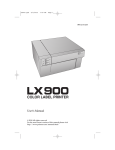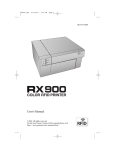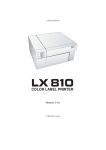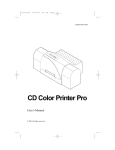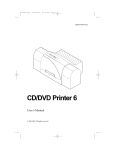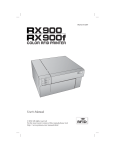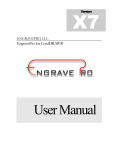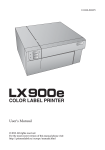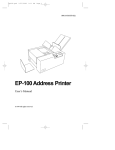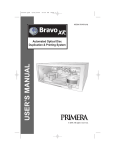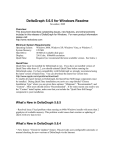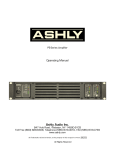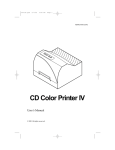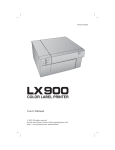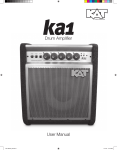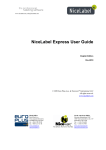Download User`s Manual
Transcript
510910.qxd 10/8/2004 12:30 PM Page i 092704-510910-(01) User's Manual © 2004 All rights reserved 510910.qxd 10/8/2004 12:30 PM Page ii Notices: The information in this document is subject to change without notice. NO WARRANTY OF ANY KIND IS MADE WITH REGARD TO THIS MATERIAL, INCLUDING, BUT NOT LIMITED TO, THE IMPLIED WARRANTIES OF MERCHANTABILITY AND FITNESS FOR A PARTICULAR PURPOSE. No liability is assumed for errors contained herein or for incidental or consequential damages in connection with the furnishing, performance, or use of this material. This document contains proprietary information which is protected by copyright. All rights are reserved. No part of this document may be photocopied, reproduced, or translated into another language without prior written consent. Trademark Acknowledgments: IBM is a registered trademark of International Business Machines Corporation. Windows is a trademark of Microsoft Corporation. All other trademarks are the property of their respective owners. CandelaColor® Charged by Pictographics is a registered trademark of Pictographics International Corporation. Printing History Edition 1.0, #092704, © Copyright 2004, All rights reserved. FCC Compliance Statement: This device complies with part 15 of the FCC rules. Operation is subject to the following two conditions: (1) this device may not cause harmful interference, and (2) this device must accept any interference received, including interference that may cause undesired operation. For Users in the United States: This equipment has been tested and found to comply with the limits for a Class B digital device, pursuant to Part 15 of the FCC Rules. These limits are designed to provide reasonable protection against harmful interference in a residential installation. This equipment generates, uses, and can radiate radio frequency energy and, if not installed and used in accordance with the instructions, may cause harmful interference to radio communications. However, there is no guarantee that interference will not occur in a particular installation. If this equipment does cause harmful interference to radio or television reception, which can be determined by turning the equipment off and on, the user is encouraged to try to correct the interference by one or more of the following measures: • Re-orient or relocate the receiving antenna. • Increase the separation between the equipment and receiver. • Connect the equipment into an outlet on a circuit different from that to which the receiver is connected. • Consult the dealer or an experienced radio/TV technician for help. Use of a shielded cable is required to comply with the Class B limits of Part 15 of the FCC Rules. You are cautioned that any changes or modifications not expressly approved in this manual could void your authority to operate and/or obtain warranty service for this equipment. Within the U.S., this product is intended to be supplied by a UL Listed Direct Plug-in Power Unit marked Class 2 and rated 30 Vdc, 830 mA or 1.0A. For Users in Canada: This digital apparatus does not exceed the Class B limits for radio noise for digital apparatus set out on the Radio Interference Regulations of the Canadian Department of Communications. Le present appareil numerique n'emet pas de bruits radioelectriques depassant les limites applicables aux appareils numeriques de la class B prescrites dans le Reglement sur le brouillage radioelectrique edicte par le ministere des Communications du Canada. CAUTION! TO PREVENT FIRE OR SHOCK HAZARD, DO NOT EXPOSE THE UNIT TO RAIN OR MOISTURE. TO REDUCE THE RISK OF ELECTRIC SHOCK, DO NOT REMOVE EXTERIOR PANELS. NO USER SERVICEABLE PARTS INSIDE. REFER SERVICING TO QUALIFIED SERVICE PERSONNEL. OPERATE THE UNIT WITH ONLY THE PROPER ELECTRICAL SPECIFICATIONS AS LABELED ON THE PRINTER AND AC ADAPTER WARNING. Hazardous moving parts. Keep fingers and other body parts away from the paper-feed gears. WARNING. Sharp Edges. Keep fingers and other body parts away from the tear-off bar. ii 510910.qxd 10/8/2004 12:30 PM Page iii Table of Contents Section 1: Getting Started ...............................................................................1 A. Choosing a Good Location ................................................................1 B. Unpacking and Inspection.................................................................2 C. Identifying the Parts ...........................................................................3 D. Applying Power ..................................................................................4 E. Installing the Driver and Software...................................................5 Section 2: Supplies and Driver Settings......................................................7 A. About Ink Cartridges and Label Material.......................................7 B. Installing Label Stock .........................................................................7 C. Installing Ink Cartridges ..................................................................11 D. Printer Driver Settings .....................................................................13 Section 3: Using the LX800 ...........................................................................19 A. Using NiceLabel ................................................................................19 B. Creating Barcodes in NiceLabel .....................................................26 C. Printing From Other Applications .................................................29 Section 4: Troubleshooting and Maintenance ..........................................30 A. Cleaning the Printer..........................................................................30 B. Basic Troubleshooting ......................................................................30 C. Technical Support..............................................................................31 Section 5: Technical Specifications .............................................................32 Index..................................................................................................................34 iii 510910.qxd iv 10/8/2004 12:30 PM Page iv 510910.qxd 10/8/2004 12:30 PM Page 1 Section 1: Getting Started THANK YOU… ...for choosing the LX800 Color Label Printer. This printer is the perfect way for you to create customized, full color labels quickly, easily, and with a touch of class. The LX800 will print razor-sharp text and barcodes, vibrant colors, and even stunning photo-realistic photographs directly onto rolls of labels and card stocks. Operation is simple, quality is high, and printed images are durable and highly smudge-resistant. To begin using the printer, please refer to the remainder of this manual. This User's Manual is your complete step-by-step guide to quickly and easily setting up and printing with your new Color Label Printer! A. CHOOSING A GOOD LOCATION • • • • Place the printer on a flat surface in a location with adequate air circulation to prevent internal heat build up. Do not place the printer near heat sources such as radiators or air ducts, or in a place subject to direct sun light, excessive dust, mechanical vibration or shock. Allow for adequate clearance in front of the printer to accommodate the printed label stock as it is leaving the printer to avoid the possibility of binding or jamming of the label stock. Automated re-winders are recommended for larger production jobs. Allow for adequate overhead clearance for opening the top cover to allow easy access to the label stock and ink cartridges. Getting Started 1 510910.qxd 10/8/2004 12:30 PM Page 2 B. UNPACKING AND INSPECTION While unpacking your printer, inspect the carton to ensure that no damage has occurred during shipping. Make sure that all supplied accessories are included with your unit. The following items should be included: • • • • • • • • • • Printer Power Adapter Separate Power Cord Software Installer CD Color Ink Cartridge, Reorder # 53335 Dye-Based Black Ink Cartridge, Reorder # 53336 Starter roll of label stock 6" x 4" High-Gloss Tear Bar Guard (This is a white plastic shield attached to the Tear Bar for shipping and can be simply pulled from the tear bar to reveal the serrated edge. This guard is recommended for use when using pre-perforated label material.) Warranty Statement and Registration Card This manual and other printed information Save the carton and packing materials. They will come in handy when transporting the printer. 2 Getting Started 510910.qxd 10/8/2004 12:30 PM Page 3 C. IDENTIFYING THE PARTS This illustration shows the front of the LX800 with its control buttons and LED indicator lights. Top Cover Pause LED Pause Button Power LED Feed Button Ink Low LED Stop/Cancel Button Label Tear Bar The Pause Button pauses the printer AFTER the printing of the current label has finished to allow for loading of label stock and ink cartridges. The Pause LED is lit when the printer is paused. Press the Pause Button to resume printing. The Power LED indicates that the LX800 is on and ready to receive print jobs. The Feed Button is pressed in order to load label stock or form feed the label stock through the printer. When pressed in tandem with the Stop/Cancel Button, the printer will unload the installed label stock by reversing it through the printer. NOTE: Always use this procedure when to unload label material. DO NOT ALLOW THE END OF THE ROLL TO FEED THROUGH THE MACHINE! The Ink Low LED will illuminate when a cartridge has 10% or less of its ink remaining. The Stop/Cancel Button will allow you to stop the current print job. When pressed the printer will abort the current print and will go into a "Pause" state. When pressed in tandem with the Feed Button, the printer will unload the installed label stock by reversing it through the printer. The Label Tear Bar is a serrated edge for conveniently tearing your finished labels from the printer. WARNING. Sharp Edges. Keep fingers and other body parts away from the tear-off bar. Getting Started 3 510910.qxd 10/8/2004 12:30 PM Page 4 This illustration shows the input ports and power switch found on the rear panel of the printer. USB Port Power Switch Power Input Port D. APPLYING POWER 1. Locate the power adapter supplied with your printer. 2. Place one end of the adapter cord into the power port on the rear panel of the printer. 3. Plug the power cord of the adapter into an available wall outlet or surge protecting power strip. Once the power cord is connected, the printer can be switched on and off using the power switch. 4 Getting Started 510910.qxd 10/8/2004 12:30 PM Page 5 E. INSTALLING THE DRIVER AND SOFTWARE The LX800 Color Label Printer is designed to be used with nearly any IBM-PC® or compatible running Windows 2000/XP. The printer is equipped with a USB 1.0/2.0 port. This port is the means through which it receives data from your computer. To connect the printer to your computer, use the included shielded USB cable. The software installs as follows: 1. Insert the Installation CD into your computer. In a few moments the installer program should launch automatically. If not, perform the following steps: a. 2. Double click My Computer Icon, then double click the icon of the appropriate CD drive containing the software installer disc. b. Double click INSTALL.exe then click the Quick Start Install Button. Follow the on screen instructions to install the software. These steps are illustrated below: a. Apply power b. Plug in USB Cable i. After a few moments Windows detect the printer and attempt to install the printer driver. You will be prompted with a dialog box like the one shown here: Click “Continue Anyway”. Getting Started 5 510910.qxd 10/8/2004 12:30 PM Page 6 ii. Once installed the "Color Label Printer" icon will appear in the printers folder. 3. Once the printer driver is properly installed, the installer application will prompt you to install label stock and the ink cartridges. You will also be asked to complete a cartridge calibration procedure. Follow the on screen instructions to complete this install. More information on installing the label stock and ink cartridges is available in Section 2 of this manual. 4. Next the installer will install NiceLabel. NiceLabel is an easy-to-use software application for making your labels and creating barcodes. 5. Click Finish to complete the install. 6 Getting Started 510910.qxd 10/8/2004 12:30 PM Page 7 Section 2: Supplies and Driver Settings A. ABOUT INK CARTRIDGES AND LABEL MATERIAL (PIGMENT-BASED VS. DYE-BASED INKS, GLOSS VS. PLAIN PAPER) For full-color printing, a 3-color ink cartridge is available. This cartridge contains the three process-color inks of yellow, magenta, and cyan, which combine to produce up to 16.7 million printable colors and works very well on all label stocks. Two different Monochrome ink cartridges are available for the LX800. First is the Pigment-Based Monochrome Black. Pigment-Based inks are for use with plain paper stock. Plain paper stocks are desirable because of their low cost but offer little resistance to water. The second type of black cartridge available is the Dye-Based Monochrome Black. Dye-Based inks are formulated for high-gloss and semi-gloss label stock. Ink Recommended Label Stock Pigment-Based Monochrome Plain Paper Label Stock Black PN 53020 Dye-Based Monochrome Black Semi-Gloss and High-Gloss PN 53336 Paper Label Stock Mono Ink/ Label Compatibility NOTE: If you are printing barcodes on your labels it is recommended that you test your combination of label stock and cartridge to make sure the barcodes can be read accurately prior to committing to a large purchase of supplies. B. INSTALLING LABEL STOCK Your LX800 will utilize a wide variety of paper label stock. As long as the label stock is paper and can receive ink jet printing and is within the allotted size, it will work in the LX800. Primera carries a large variety of paper label stock that has been converted and ready for use with your printer. Supplies and Driver Settings 7 510910.qxd 10/8/2004 12:30 PM Page 8 NOTE: All the stock listed on Primera's supply order sheet is semi-gloss or gloss and is meant for use with the Dye-Based Black Ink 53336. You can use other stock if you like. If using plain paper stock, you will most likely have success with the Pigment-Based Black Ink 53020. It is recommended that you test your stock and ink combinations before committing to a large supply purchase. Other paper label stock may also work properly as long as it is in specification. Use the following table to identify if a certain stock is within specification: Max Roll Core Minimum Maximum Minimum Maximum Outside Inside Label Label Label Label Diameter Diameter Width Width Height Height Inches Millimeters 6 3 1.5 8.0 .75 24 152.4 76.2 38.1 203.2 19.05 609.6 Label Stock Compatibility Chart The following illustration shows the internal parts you should be familiar with when loading stock into your printer: Fixed Throat Guide Dancer Arm Throat Guide Roll Arm ! WARNING. Hazardous moving parts. Keep fingers and other body parts away from the paper-feed gears. 8 Supplies and Driver Settings Roll Guide Sensor Position Adjust 510910.qxd 10/8/2004 12:30 PM Page 9 Installing Label Stock The following steps will guide you through loading label stock in your LX800: Make sure Power is connected and Printer is on. 1. Open the Top Cover. 2. Flip the Label Dancer Arm up. 3. Lower the Roll Guide and pull it outward to make room for your label stock. 4. Pull the Throat Guide outward to make room for the label stock. 1. Open Cover 2. Flip Dancer Arm Up 4. Pull Throat Guide Out 3. Lower the Roll Guide and Pull it Outward 5. Remove any shipping tape from your label stock roll to ensure that it can unroll freely, making certain that no adhesive portion is exposed. It is important to note that any exposed adhesive surface can attach itself the the inner workings of the print mechanism and can cause media to not feed or jam in the printer. 6. Place your roll of label stock on the Roller Assembly and push it inward until it touches the stop. Supplies and Driver Settings 9 510910.qxd 10/8/2004 12:30 PM Page 10 7. Slide the Roll Guide assembly inward until it makes contact with the roll then flip the Roll Guide up. This will automatically position the guide so that it is close enough to the roll to guide it without impeding the unwinding of the roll. 8. Flip Label Dancer Arm down so that it rests on the roll. 9. Move the Throat Guide there is just slightly more space between the adjustable and fixed throat guide than the width of the label stock. This guide should be tight enough to keep the label stock feeding straight but not so tight that it pinches the label stock. This could cause poor print quality or even media feed problems. 6. Place label stock on Roller Assembly. 7. Flip Label Dancer Arm down. 10. Pull leading edge of label stock. 9. Slide Throat Guide inward. 8 Slide Roll Guide assembly inward. 10. Pull the leading edge of the label stock to unwind 6 to 8 inches worth of stock. Guide the leading edge of the stock over the top of the Label Dance Arm and place it into the throat of the print mechanism guiding it under the label stock sensor. Once the sensor "sees" the stock the printer will automatically feed it forward and position it. 11. The Label Sensor in the LX800 can identify the start of the label by differentiating between the reflectivity of the label and the backing. The LX800 can also sense through-hole 10 Supplies and Driver Settings 510910.qxd 10/8/2004 12:30 PM Page 11 stock as well. If you are using label stock that has a hole punch to identify a transition from backing to label, you can adjust the Sensor Position Adjust tab to position it over the identifying mark. The Sensor Position Adjust tab has a guide in inches and milimeters that will help you identify where to set the tab to align the sensor over any identifying mark. To do this, simply measure the length of the hole or label mark and set the sensor to 1/2 the distance of the hole or mark. For instance, if you have a 1/2 inch hole, set the guide to 1/4 inch to make sure the sensor is in the middle of the through hole. 1” 1/2” 1” Through-hole Black Stripe 2.5 (63.5) 2.0 (50.8) 1.5 (38.1) 1/2” 1.0 (25.4) 0.5 (12.7) 0.0 in. (0.0) (mm) Sensor Position Adjustment NOTE: If you are using black stripe sensing label material you will need to identify this in the printer driver under the Sensor Type setting. Please refer to section D later in this chapter for more information on changing driver settings. 12. Now your stock is installed. Please read the following section to install your cartridges. Supplies and Driver Settings 11 510910.qxd 10/8/2004 12:30 PM Page 12 C. INSTALLING INK CARTRIDGES Your LX800 has a built-in ink tracking system. This system is designed to warn you if your ink cartridges are low on ink. This ensures your labels will print properly and that the printer can create large batches of labels unattended and worry-free. In order to make this system work properly, the cartridges must be changed using the procedure listed below. Failure to follow this procedure could result in inaccurate ink level tracking and could cause your print quality to suffer. Ink cartridges are changed as follows: 1. Click Start>Printers and Faxes 2. Right-click on the Color Label Printer Icon 3. Click on Printer Preferences from the drop-down menu 4. Find the option labeled "Clean/Change Cartridges & Check Ink…" and click "Properties" 5. Click "Change Cartridge(s)" 6. Open the Top Cover of the printer 7. The Cartridge Carrier will align itself to the center of the print area. 8. Press the Cartridge Cover Release to open the Cartridge Holder 9. Replace/install the cartridge 10. Push cartridge cover downward until it snaps in place. 1 2 3 11. Click OK on your screen to indicate the new cartridge is now installed. Once you click OK you will be prompted to align the cartridge. The LX800 will automatically align the cartridge for you as follows: 12 Supplies and Driver Settings 510910.qxd 10/8/2004 12:30 PM Page 13 a. For Alignment you will need to have installed label stock that is equal to or larger than 3" x 3" (76.2mm x 76.2 mm). See If your stock meets this requirement, skip to step d. b. If your installed stock is smaller than 3" x 3", unload your current stock by simultaneously pressing the Feed and Cancel buttons. The LX800 will reverse the label stock so that it can be removed from the printer c. Load a sheet of paper, not to exceed 8.25 inches or 209 millimeters in width, by first pulling the Throat Guide all the way out, then placing it In the feed area, once the printer senses the page it will pull it into place d. Click OK e. The LX800 will print the alignment test and scan it into memory. Once the alignment is complete you will see a confirmation dialogue box on your monitor. Click OK. You have successfully installed the ink cartridges. D. PRINTER DRIVER SETTINGS Once the printer driver has been successfully installed, you will need to set the driver up with the appropriate print options. Refer to the following steps to change or verify your printer driver options: 1. Click the Start button, then click Printers and Faxes. Rightclick on the Color Label Printer Icon and select Printing Preferences from the drop-down menu. Supplies and Driver Settings 13 510910.qxd 10/8/2004 12:30 PM Page 14 NOTE: Most applications allow you to change these same printer driver options from their "Print" and/or "Printer Setup" screens. This means that you don't have to go back to the main printer setup window each time you want to change a setting or option in the printer driver. These applications will usually give you the same choices and options, but in a slightly altered format. Most applications do not save your printer driver option changes, but instead only use your changes for the current image. 2. In Windows 2000/XP the Layout and Paper/Quality tabs appear; refer to the remainder of this section for a description of each printer driver option. Label Size This option is set to Custom as a default. Even though you can click Properties and key in the dimensions of your label, this is best done from your labeling software. It is recommended that the Label Size setting is left to "Custom". Orientation There are two settings for orientation, Portrait and Landscape. If your text and graphics print left to right or as shown on the screen, select portrait . If you wish your printing to rotate 90 degrees from what you see on the screen so it is printing horizontally, select landscape as your orientation. Portrait Landscape 14 Supplies and Driver Settings 510910.qxd 10/8/2004 12:30 PM Page 15 Print Quality There are 6 levels of print quality in the driver. The lower the Quality, the faster the print. Quality 1 provides the fastest print available while Quality 6 provides the best photo quality. It is recommended that you experiment with the different levels when designing your label to find a good balance between print quality and print speed. The default setting for this is Quality 2. Ink Saturation This option controls the amount of ink used when printing an image. The default setting is 100%, which will provide the most accurate color matching. If the ink is not drying fast enough, you can decrease the Ink Saturation to lessen the amount of ink that is applied to the label. Listed under Ink Saturation, you will see two additional settings, Cartridge Alignment and Enable Low Ink Warning. Cartridge Alignment will align the Black Cartridge to the Color Cartridge. You will automatically be prompted to perform this alignment each time you install a new cartridge. If you find that the black objects are not aligning properly with color objects on your label you can run the alignment procedure from the printer driver. Click on Cartridge Alignment and you will see a Properties button. Press this button to start the Alignment procedure. You will be prompted to have label stock of 3"x3" (76.2mm x 76.2mm) or larger. If the loaded stock does not meet this requirement it can be unloaded by pressing the Feed and Cancel buttons simultaneously. Insert larger stock or feed a sheet of paper (no wider than 8.25 inches or 209mm) into the print area then click OK to continue. The printer will print an alignment pattern then scan that pattern into memory automatically. Once it has finished you will see a dialog box stating that alignment values have been saved. Follow the on-screen instructions to either change to a new cartridge or continue printing with the low cartridge. Supplies and Driver Settings 15 510910.qxd 10/8/2004 12:30 PM Page 16 The Enable Low Ink Warning is set to Yes by default. This setting will allow the printer to pause if any cartridge has less than 10% of its ink remaining. When you are low on ink, the printer will stop printing, the Ink Low LED on the front of the printer will illuminate and you will see a dialog box displayed on your monitor. To continue, press the Pause Button. The Low Ink LED will stay lit until the cartridge has been changed. Clean/Change Cartridges & Check Ink Levels Click this setting and you will see a Properties button. Click Properties and you will see the ink levels as well as buttons allowing you to either clean or change your ink cartridges. Clean/Purge If it has been more than 48 hours since your last print or if your print quality has deteriorated with bands or lines it is recommended that you clean the cartridges. This is done by clicking the Clean/Purge button. The Clean Purge is done as follows: a. You will be prompted to load label stock of 4"x 4" (101.6 mm x 101.6mm) or larger, into the printer. If you have stock of this size or larger, simply click OK. b. If not, press the Feed and Cancel buttons found on the front of the printer simultaneously to reverse the stock out of the print feed mechanism. Load a sheet of paper, not to exceed 8.25 inches or 209 millimeters in width, into the feed mechanism by pulling the Throat Guide all the way out to make room for the paper then inserting a sheet into the print feed area. Once the sensor "sees" the paper it will automatically feed it into position and will begin to print. 16 Supplies and Driver Settings 510910.qxd 10/8/2004 c. 12:30 PM Page 17 The printer will print a purge pattern where swaths of each color are printed to clean the jets of the cartridge. A series of diagonal lines are printed in each color of both cartridges. By examining this pattern you can tell if the cartridge is firing all jets or if the cartridge is dirty and requires further cleaning. While the blocks of color may not print solidly, it is important that the diagonal lines be continuous. Repeat this process until all diagonal lines print without breaks. Change Cartridge(s) Click the Change Cartridge(s) button to move the cartridges into position for easy access for replacement. For more information on this see Section 2-C. When installing cartridges you will be prompted to align your cartridges as described earlier in this section. Sensor Type Sensor Type refers to the method the LX800 will use to center the print image on your label material. If you are using standard die-cut labels or Through-hole label material where a hole is punched through each label for alignment purposes use the Through-hole/Die-Cut setting. Use Reflective for black stripe sensing label material where a pre-printed line indicates the break between labels. Rewinder Mode This defaults to No. When set t no, the printer will align your labels with the tear off bar for easy removal. This mode can be set to Yes when using the LX800 with an automatic rewinder. Stock Type There are two types of stock that can be fed through the LX800, Roll Stock or Fan-Fold. Select the desired stock. This setting will default to Roll Stock. Supplies and Driver Settings 17 510910.qxd 10/8/2004 12:30 PM Page 18 TOF Offset TOF stands for Top of Form and this setting allows you to fine tune the alignment of your printing on your label stock. This will be factory calibrated. If fine tuning is needed, increase this setting to move the image down on the label; decrease this setting to move the image up on the label. The unit of measure is 0.1mm. Tear Off Offset If Rewinder Mode (described earlier in this section) is set to No, the LX800 will present your labels over the Tear Bar for easy removal. This is set at the factory. If fine tuning is needed to align the break in your label stock over the Tear Bar, increase this setting to eject the label further; decrease this setting to eject the label stock less. The unit of measure is 0.1 mm. 18 Supplies and Driver Settings 510910.qxd 10/8/2004 12:30 PM Page 19 Section 3: Using the LX800 A. USING NICELABEL Your LX800 ships with a basic version of Niceware's NiceLabel software. This easy-to-use software is designed to allow you to create full color labels with text and barcodes quickly and simply. The following is a tutorial to guide you through creating and printing a sample label. Launch NiceLabel from your computer's Start Menu. Take a moment to familiarize yourself with the NiceLabel Main Application Window. This will help you navigate the features of this program. Main Application Window Main Menu Bar Main Tool Bar Tool Box Bar Document Window Using the LX800 19 510910.qxd 10/8/2004 12:30 PM Page 20 Creating a label 1. Click the New Label Icon 2. You will see the Label Setup Wizard. This will guide you through setting up your label a. from Main Tool Bar Select your Printer. This should be the Color Label Printer. Then click Next b. Set the dimensions of your label and unit of measure and click Finish. 20 Using the LX800 510910.qxd 10/8/2004 3. 12:30 PM Page 21 Now you will see your label in the Document Window. You can start to design your label using Tools from the Tool Box. First, we will use the Text Tool. Text Tool Icon Text Cursor a. Click the Text Tool Icon in your Toolbox, then move the text cursor over the Document Window and click in the location where you want to enter text. There is no need to be exact, once you enter your text it can easily be resized and/or moved about the label. Upon clicking in the Document Window, you will see a prompt to start typing your text. b. When finished typing, click anywhere in the Document Window and you will see the text appear in a box with "edit handles". You can drag and resize the text anywhere in the document window. If the text is dragged off of the printable area, NiceLabel will turn the text red as a warning. This will not change the color the text prints out as when sent to the printer but is only used as a warning to let you know you may not be printing the full text on your label. Using the LX800 21 510910.qxd 10/8/2004 4. 12:30 PM Page 22 Now, insert a barcode. BarcodeTool Icon a. Barcode Cursor Click the Barcode Tool Icon from the Toolbox. You will now have a Barcode Cursor that can be positioned anywhere within the Document Window. Position your cursor in the general area where you wish your barcode to print and click to start entering your barcode information. There is no need to be exact, once you create your barcode it can easily be moved and/or resized. Once clicked, you will see the Barcode Wizard. b. The first screen in the Barcode Wizard will allow you to select the type of Barcode you wish to print. You can also enter the data to be used in the barcode. For this we are doing a simple UPC-A barcode. For more information on other types of barcodes, please see Section 3-B. Creating Barcodes in Nicelabel. 22 Using the LX800 510910.qxd 10/8/2004 c. 12:30 PM Page 23 Click Define to change the type of Barcode or to make changes to the options associated with your particular type of barcode. You will also want to set the Symbol Height and X Expansion Factor d. Click the Human Readable tab to change the font that prints under your barcode Using the LX800 23 510910.qxd 10/8/2004 e. 12:30 PM Page 24 Click OK, then click Finish and your Barcode will be placed on your label with "Edit Handles" to allow you to move and resize your barcode. Graphics Tool Icon 5. Graphics Cursor Now insert a graphic. Click on the Graphics Tool Icon in the toolbox. You will now see a Graphics Cursor. Drag the cursor to the general area where you wish to place the graphic and click to get an Open dialog box. You will be prompted to browse for graphic files. Nicelabel will accept bitmap graphics formatted as BMP, JPG, TIF, WMF, PNG and many more. 24 Using the LX800 510910.qxd 10/8/2004 a. 12:30 PM Page 25 Click Open and the graphic will be imported with edit handles so you can easily move and resize your graphic. b. There are other tools at your disposal to align the object or add shapes. On the right side of the screen you will see alignment tools so you can align the objects on your label in relation to each other. Select objects by clicking on them or clicking and dragging a "lasso" around multiple objects or by holding down the SHIFT key and clicking on each object individually. You can also center these objects by right clicking on a selected object and choosing Align from the drop-down menu. If you wish to center your object on the label choose the appropriate centering options and check the Align to Label checkbox. Using the LX800 25 510910.qxd 10/8/2004 12:30 PM Page 26 You are now ready to print your label. Click File then Print from the main menu. Choose your number of copies and click OK. Congratulations! You have successfully created and printed your first label. The rest of this section will explain in more detail how to use barcode labels. Also, you can find more tips and hints by simply clicking Help then Contents in the main menu. c. B. CREATING BARCODES IN NICELABEL Barcode Tool Icon a. Barcode Cursor Click the Barcode Tool Icon from the Toolbox. b. You will now have a Barcode Cursor that can be positioned anywhere within the Document Window. Position your cursor in the general area where you wish your barcode to print and click to start entering your barcode information. Once clicked, you will see the Barcode Wizard. i. The first screen in the Barcode Wizard will allow you to select the type of Barcode you wish to print. You can also enter the data to be used in the barcode. 26 Using the LX800 510910.qxd 10/8/2004 12:30 PM Page 27 ii. Click Define to change the type of Barcode. iii. This contains four tabs, General, Check Digit, Human Readable and Details. iv. The General Tab (shown on page 27) allows you to choose the appropriate barcode type from the Available barcodes: menu. You can choose one- or two-dimensional barcodes. Note that different barcode types have different requirements - some of them only allow numbers to be encoded, while others only allow upper case characters. For the further help on the barcode types contact your supplier Using the LX800 27 510910.qxd 10/8/2004 12:30 PM Page 28 Available barcodes types are listed here: EAN and UPC EAN-8, EAN-8 + 2-digit supplement, EAN-8 + 5-digit supplement, EAN-13, EAN-13 + 2-digit supplement, EAN-13 + 5-digit supplement, EAN-14, DUN-14, UPC Case Code, UPC-A, UPC-A + 2-digit supplement, UPC-A + 5-digit supplement, UPC-E, UPC-E + 2-digit supplement, UPC-E + 5-digit supplement, EAN.UCC 128, SSCC, Bookland, Addon 2, Addon 5 Linear Interleaved 2 of 5, ITF 14, ITF 16, Code 39, Code 39 Tri Optic, Code 39 Full ASCII, Code 32, Code 93, CODE 128 (A, B and C subsets), MSI, Codabar, Postnet-32, Postnet-37, Postnet-52, Postnest-62, Kix, Pharmacode RSS Linear RSS symbologies RSS14, RSS14 Truncated, RSS14Stacked, RSS14 Stacked Omnidirectional, RSS Limited, RSS Expanded 2D Barcodes Composite RSS symbologiesRSS14, RSS14 Truncated, RSS14 Stacked, RSS14 Stacked Omnidirectional, RSS Limited, RSS Expanded, UPC-A, UPC-E, EAN-8, EAN-13, EAN.UCC 128 & CC-A/B, EAN.UCC 128 & CC-C 2D-Pharmacode, PDF-417, DataMatrix, MaxiCode, Aztec, QR, Micro QR, Codablock F, MicroPDF Define the barcode dimensions in the Barcode Dimensions Field. The height is set in cm by entering the appropriate number in the Symbol Height Field. The width of the barcode is set as the X Expansion factor. Note that the width can be set only in pre-defined standard steps. When you change the barcode dimension directly from the screen by moving the drag handle, the changed dimension will also appear in this dialog box. Some of the barcode types also allow the definition of Narrowto-wide bar ratio. It can only be set from the predefined steps in the pull-down menu - 1:2, 1:3 or 2:5. Base element width (mils) is calculated automatically from the X expansion factor. 28 Using the LX800 510910.qxd 10/8/2004 v. 12:30 PM Page 29 The Check Digit Tab will allow you to include a system automated check digits or enter your own. Check digits can be disabled on some barcodes from this tab as well. vi. The Human Readable Tab allows you to manipulate the human readable text printed with your barcode. Here you can disable Human Readable, select position (above or below the barcode), include a check digit, and choose your font type and scaling. vii. The Details Tab allows you to set some further details of the barcode presentations on the printer. These settings are listed here: Include Quiet Zones will enable the software to automatically create the necessary amount of free space before and after the barcode symbol by drawing an unprintable buffer area around the barcode symbol on the screen. Descender Bars allows EAN 13, EAN 8, UPC A and UPC E to print longer first, middle and last bars when this option is selected. Mirror Horizontally will allow the barcode to be printed as a graphic and will so it can be mirrored over the horizontal axis. Mirror Vertically allows the barcode to be printed as a graphic so it can be mirrored over the vertical axis. Intercharacter Gap: Some barcodes allow you to change the gap between characters in the barcode (e. g. Code-39). The barcode prints as a graphic. Include EAN white space: A special character is inserted before and/or after the barcode. It indicates the width of the barcode. If you place any other object in the extent of the barcode, it will reduce the readability of the barcode. This option is valid for EAN barcode types. C. PRINTING FROM OTHER APPLICATIONS Because the LX800 installs as a standard Windows printer driver, it will print from virtually any Windows 2000/XP application. All you will need to do is create a custom page size the equivalent of your label stock size with margins set to "0". Then create your label and click File> Print. Select the Color Label Printer as your printer type and select the number of copies. Click OK and your LX800 will print your labels. Using the LX800 29 510910.qxd 10/8/2004 12:30 PM Page 30 Section 4: Troubleshooting and Maintenance A. CLEANING THE PRINTER It may be necessary to clean the ink cartridge nozzles if the your labels are printing with horizontal banding or if you suspect an ink cartridge nozzle has become slightly dried out or clogged. Refer to the cleaning procedure explained within the Clean/ Purge description of Section 2-D to clean the cartridge nozzles. If any ink has gotten on to the printer casing itself, the case of the printer can be cleaned with an ammonia based window cleaner and a lint-free cloth. B. BASIC TROUBLESHOOTING Generally, when a malfunction or an abnormal condition occurs, the "PAUSE " LED will keep blinking repeatedly and printing and communication between the host PC and the printer will cease. After the problems have been solved, press STOP/CANCEL to clear the error and continue printing. Here is a general guide to some common error conditions: Possible Problems Indicator Solutions Remarks Printer ejects media or can not find the start of the label, then times out with flashing "PAUSE" LED • Check Media Path • Check Position of sensor Refer to section 2-B for proper installation of label stock Image printing Label is not feeding off center or off straight, images the edge of the look misaligned label • Check media path • Check throat guide and roll guide Refer to section 2-B for proper installation of label stock Out of label stock • Install new label · stock/media Refer to section 2-B for proper installation of label stock Missing gap Fast flashing "PAUSE" LED 30 Troubleshooting and Maintenance 510910.qxd 10/8/2004 Possible Problems 12:30 PM Page 31 Indicator Solutions Remarks Out of ink Steady lit "LOW INK" and "PAUSE" LED and/or poor print quality • Replace ink · cartridges • Perform alignment · • Perform cleaning Refer to section 2-C for proper installation of ink cartridges Media/label stock jam Printer stalls, labels appear damaged, and "PAUSE" flashes quickly • Press "FEED" and "STOP/CANCEL" simultaneously to reverse media • Be sure to clear and labels from inside of printer especially in the print path· • Load new media Refer to section 2-B for proper installation of label stock C. TECHNICAL SUPPORT If you have difficulty operating your Color Label Printer, the procedures in this manual should, in most cases, solve the problem. If you still have difficulty, contact Primera's Technical Support Department. You can reach tech support by phone, fax, email or mail at the following: Primera Technology Technical Support Department Two Carlson Parkway North Suite 375 Plymouth, MN 55447-4446 Phone: 763-475-6669 Fax: 763-475-6998 Email: [email protected] Web: www.primera.com Live phone support is available Monday through Friday, 8 AM to 6 PM, Central Standard Time. Email support is available 7 days a week. Primera's Technical Support Team will in most cases resolve your issues over the phone and will also be your point of contact if you need to return the LX800 for service. Troubleshooting and Maintenance 31 510910.qxd 10/8/2004 12:30 PM Page 32 Section 5 : Technical Specifications Print Method: Print Resolutions: Inkjet 4800 x 1200 dpi, 1200 x 1200 dpi, 600 x 600 dpi Print Speeds: Approximately 2" (51mm) per second for black Approximately 1.5" (38mm) per second for color + black Approximately 10" per second feed rate Ink Cartridges: #53335 Color (CMY) #53336 Black Dye-Based (Kd) #53020 Black Pigment-Based (Kp) Colors: 16.7 million Max. Print Width: 8" (203mm) Max. Media Width: 8.25" (210mm) Min. Media Width: 1.5" (38mm) Max. Print Length: 24" (610mm) Min. Media Length: 0.75" (19mm) Media Types: Roll-fed pressure-sensitive labels, roll-fed tags Media Sensing: Moveable see-through sensor for die-cut labels and reflective for tags with black stripe sensing Supply Roll: 6" (152mm) maximum diameter on 3" (76mm) core Ink Level Warning: Calculates actual number of prints remaining based upon ink usage of graphics being printed (patent-pending) Indicator Lights: Power, Pause, Ink 32 Technical Specifications 510910.qxd 10/8/2004 12:30 PM Page 33 Controls: Pause, Feed, Stop/Cancel Operating Systems: Windows XP/2000 Data Interface: USB 1.1/2.0 Minimum System: Pentium® III computer or better, 128MB RAM, 500MB free hard drive space, USB 1.1/2.0 port Label Design Software: NiceLabel™ SE Primera Edition included. Can also be used with most other popular Windows-based label design software programs Electrical Rating: 12VDC, 3.0A Power Requirements: 100-240VAC, 50/60 Hz, 60 watts Certifications: UL, UL-C, CE, FCC Class B Weight: 29 lbs. (13.2 Kg) Dimensions: 17"W x 9.1'H x 15.5"D (432mmW x 231mmH x 394mmD) Warranty: One year, parts and labor Technical Specifications 33 510910.qxd 10/8/2004 12:30 PM Page 34 Index Alignment Tool...............................................................................25 Applying Power................................................................................4 Available Barcode Types in NiceLabel ......................................28 Barcode Wizard ..................................................................22, 26, 27 Cartridge Alignment .....................................................................15 Check Digit Tab..............................................................................29 Clean/Purge Ink Cartridges .........................................................16 Dancer Arm.................................................................................9, 10 Details Tab.......................................................................................29 Dye-Based Monochrome Black.....................................................7 Dye-Based Ink ..................................................................................7 Feed Button .......................................................................................3 General Tab .....................................................................................27 Gloss/Semi-Gloss Label Stock ......................................................7 Human Readable Tab..............................................................24, 29 Importing Graphics .......................................................................24 Ink Low LED...............................................................................3, 16 Ink Saturation.................................................................................15 Installing Ink Cartridges ..............................................................12 Installing Label Stock .................................................................7, 9 Installing the Driver and Software ..............................................5 Label Size ........................................................................................14 Label Stock Compatibility .............................................................8 Label Tear Bar ...................................................................................3 Low Ink Warning ...........................................................................15 Orientation ......................................................................................14 Pause LED..........................................................................................3 Pigment-Based Monochrome Black .............................................7 Pigment-Based Ink ..........................................................................7 Power LED.........................................................................................3 Print Quality ...................................................................................15 Printer Driver Settings..................................................................13 Printing ............................................................................................29 Roll Arm ............................................................................................8 Roll Guide .........................................................................................8 Sensor Position Adjustment ..........................................................8 34 Index 510910.qxd 10/8/2004 12:30 PM Page 35 Sensor Type .....................................................................................17 Stop/Cancel Button..........................................................................3 Rewinder Mode..............................................................................17 Tear Off Offset................................................................................18 Throat Guide.....................................................................................8 TOF Offset.......................................................................................18 Troubleshooting .............................................................................30 Using NiceLabel.............................................................................19 Index 35 510910.qxd 10/8/2004 12:30 PM Page 36 Printed in the United States of America P/N 510910









































